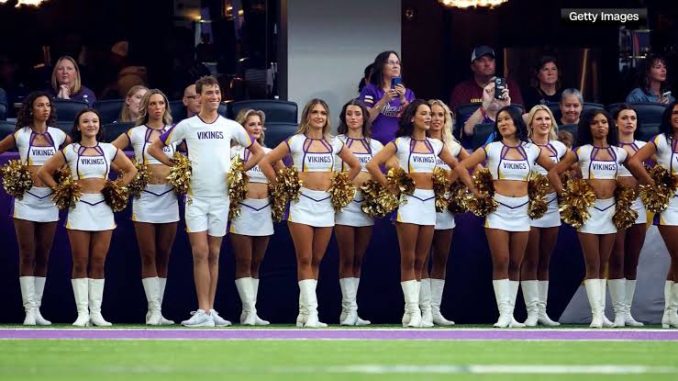
The Minnesota Vikings have made headlines off the field this week, not for a blockbuster trade or a dazzling touchdown, but for a cultural moment that has once again stirred debate about gender, sports, and society. For the first time in franchise history, the Vikings added a male cheerleader to their official squad — a decision that drew a mix of praise, curiosity, and, inevitably, criticism from some corners of the fan base.
The inclusion itself should not be groundbreaking in 2025. Professional cheerleading squads across the NFL, NBA, and college sports have included men for years. Teams like the Los Angeles Rams, New Orleans Saints, and Baltimore Ravens have long featured male cheerleaders, and their presence is neither new nor particularly controversial. Yet, the Vikings’ move sparked conversation precisely because it challenged traditional stereotypes about what a football cheerleader should look like — and because one critic decided to make it an issue.
The critic in question, whose social media post quickly made the rounds, expressed visible discomfort with the idea of a man joining what he considered to be a role reserved for women. While he didn’t articulate exactly why the addition bothered him, his tone suggested unease with what he perceived as a challenge to gender norms. Some observers noted that perhaps his discomfort stemmed from associating cheerleading primarily with the objectification of women — something a male presence interrupts. Others suggested the criticism was rooted in simple insecurity.
Whatever the case, the backlash didn’t go unanswered. Enter the viral clapback that flipped the narrative on its head:
“Do people understand that focusing on the 1 male cheerleader standing with 20 beautiful women cheerleaders is in fact, gayer than actually being gay?”
The retort, sharp and witty, spread rapidly across Twitter, Instagram, and TikTok, drawing thousands of likes and reposts. In one sentence, it captured both the absurdity of the outrage and the hypocrisy of those choosing to fixate on one man in a sea of women. Rather than putting the male cheerleader under a microscope, the response put the critic’s reaction in the spotlight, suggesting that obsessing over his presence revealed more about the complainer than about the cheerleader himself.
And that, perhaps, is the real story here: the Vikings’ decision to include a male cheerleader was not just about athletic diversity or gender inclusion — it became a mirror reflecting broader societal tensions. On one side are those who embrace progress and recognize that talent and enthusiasm, not gender, define a good cheerleader. On the other side are those who cling to outdated notions of masculinity, femininity, and who belongs where in sports culture.
For many Vikings fans, the debate was over before it began. Social media was filled with supportive comments praising the team for moving with the times. Others pointed out that male cheerleaders bring an added dimension of athleticism, often specializing in stunts, lifts, and tumbling routines that enhance performances. To them, the fuss seemed unnecessary and even a little comical.
“Look, it’s 2025,” one fan wrote. “If the Vikings want the best cheer team in the NFL, why wouldn’t they add men? They’re athletes too.”
Another chimed in more humorously: “If I was the guy, I’d be thrilled to be the only man surrounded by 20 gorgeous women every game. Sounds like winning to me.”
The Vikings themselves have not made a big production out of the move. The organization’s official statement was brief, noting that the cheerleading team is made up of “talented individuals dedicated to energizing fans and representing the team with pride, regardless of gender.” By refusing to sensationalize the decision, the Vikings let the quality of their cheer squad — not the novelty of a male addition — speak for itself.
And yet, the moment illustrates the zeitgeist perfectly. We live in an age where negativity is loud but not necessarily dominant. For every critic determined to stir up outrage, there are thousands of sane voices ready to clap back with humor, perspective, and common sense. What might have been a brief ripple became a cultural snapshot: one man’s attempt to resist change met with a collective shrug and a viral reminder that times have changed.
In the end, the Vikings’ male cheerleader is just that — a cheerleader. His role is to hype up the crowd, energize fans, and contribute to the spectacle of NFL game day. Whether he’s gay, straight, or anything in between is irrelevant. What matters is that he, like his teammates, earned his spot on the field.
The critic may have thought he was making a point, but the point ultimately turned back on him. As the clapback made clear, sometimes obsessing over the wrong thing says more about your own hang-ups than about the thing itself. And in 2025, sports fans — at least the majority of them — seem far more interested in touchdowns, wins, and playoff runs than in outdated debates about who gets to shake pom-poms on the sideline.
For the Vikings, this isn’t just about cheerleading. It’s about being unafraid to evolve with the culture, to challenge norms, and to represent the diversity of their fan base. If the reactions are any indication, the team may have sparked a conversation, but they also earned plenty of respect along the way.
Would you like me to frame this as a straight news report (more journalistic) or lean harder into a culture/think-piece vibe with a sharper, sassier tone?
Leave a Reply